TOVEL UPSIDE-DOWN
Tiziano Camagna, Andrea Forti

Lake Tovel, also known as the Red Lake, owes its fame to summer blooms caused by an alga of the Dinophyceae group . 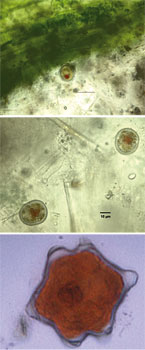 This alga, which has been called Glenodinium sanguineum Marchesoni since 1941, has been described as a species with a considerable morphological and chromic plasticity. Following the studies carried out by the Fondazione E. Mach (FEM) in San Michele all’Adige, it is now known that in reality this alga is a ‘species complex’ composed of three algae, which explains the high ‘plasticity’ of Glenodinium sanguineum Marchesoni. The three species are the following: Baldinia anauniensis (the green form), Borghiella dodgei (the brown form) and Tovellia sanguinea (the ‘real’ red form). These algae are always present in the lake, but due to the different and less intense use of the lake’s overlying pastures, the consequent scarse trophic conditions do not permit a bloom. This alga, which has been called Glenodinium sanguineum Marchesoni since 1941, has been described as a species with a considerable morphological and chromic plasticity. Following the studies carried out by the Fondazione E. Mach (FEM) in San Michele all’Adige, it is now known that in reality this alga is a ‘species complex’ composed of three algae, which explains the high ‘plasticity’ of Glenodinium sanguineum Marchesoni. The three species are the following: Baldinia anauniensis (the green form), Borghiella dodgei (the brown form) and Tovellia sanguinea (the ‘real’ red form). These algae are always present in the lake, but due to the different and less intense use of the lake’s overlying pastures, the consequent scarse trophic conditions do not permit a bloom.
Since 1964 Lake Tovel no longer turns red, although it is certainly one of the most beautiful lakes in the entire Alpine range. It is embedded in a dolomite valley and bordered to the south by the Santa Maria della Flavona valley which climbs up to the Grostè pass. To the west it is dominated by the impending and harsh northern Brenta range, composed of the peaks of Pietra Grande and Vagliana, lying on the gravel and the lush green pastures of Malga Tuena.
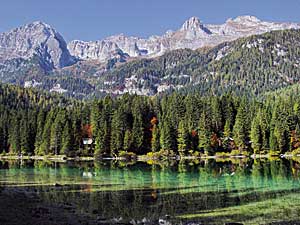 When you reach the front of the northern shore near outlet, the Tresenga stream, where there is a view of the entire lake, the emotion it generates is similar to the feeling you get by looking at a painting by the English landscape painter J. Constable: a true and authentic kaleidoscopic of concentrated emotion consisting of a set of colours and shapes which instils an atmosphere of spirituality and a sense of calm like no other. As with other experiences in life, once is not enough. Tovel is worth numerous visits to allow you to better understand its potential and the many facets of its beautiful colours: the predominance of green, typical in the summer, the impressionist palette of autumn, accompanied by a transparent green colour – the blue of its waters, like a mirror reflecting the surrounding peaks. When you reach the front of the northern shore near outlet, the Tresenga stream, where there is a view of the entire lake, the emotion it generates is similar to the feeling you get by looking at a painting by the English landscape painter J. Constable: a true and authentic kaleidoscopic of concentrated emotion consisting of a set of colours and shapes which instils an atmosphere of spirituality and a sense of calm like no other. As with other experiences in life, once is not enough. Tovel is worth numerous visits to allow you to better understand its potential and the many facets of its beautiful colours: the predominance of green, typical in the summer, the impressionist palette of autumn, accompanied by a transparent green colour – the blue of its waters, like a mirror reflecting the surrounding peaks.
However, if by admiring the lake from its sides, from above, can give us strong and intense emotions, what can be revealed about what lies beneath the surface of the water, which the cold and hostile waters don’t permit you to see? Only in recent years, which have seen the exponential development of diving equipment, such as the introduction of dry suits and the preparation of gas mixtures suitable for diving to specific depths, has it been possible to investigate the darkness of the lake’s depths with a certain amount of safety.
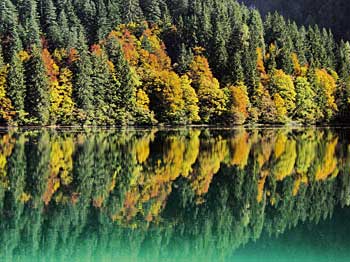 Since the beginning of last century, iconography and period photos have shown the monumental presence of a fir tree emerging from the north–east part of the lake. The tree is no longer visible from the shores of the lake because of the effect of the ice, which invariably appears at the beginning of December and lasts until April, which has truncated the cusp, thereby concealing its presence. However, if you cross the lake by boat, you can detect the presence of the tree which is located a few metres below the surface. Thus, motivated by curiosity and the confidence derived from experience, some divers decided to explore the depths of the lake. Since the beginning of last century, iconography and period photos have shown the monumental presence of a fir tree emerging from the north–east part of the lake. The tree is no longer visible from the shores of the lake because of the effect of the ice, which invariably appears at the beginning of December and lasts until April, which has truncated the cusp, thereby concealing its presence. However, if you cross the lake by boat, you can detect the presence of the tree which is located a few metres below the surface. Thus, motivated by curiosity and the confidence derived from experience, some divers decided to explore the depths of the lake.
What you need to know, according to the large amount of literature on the lake, is that Tovel is a lake created by a landslide barrier, after a glacial retreat, where falling Marocche rocks contributed to shaping the current basin in two quite distinct phases: the first phase invaded the central area, making it reach a height of about twenty feet, while the second was caused by a large landslide which blocked the position of the effluent, submerging part of the forest to the north - east and shaping what we see today, making it reach its current depth of thirty-eight and a half feet. This phase was confirmed by a carbon dating analysis carried out on some specimens of fir submerged during the latter mutation. In fact, at the bottom of the lake, in the north – east area, there is still what is erroneously called a fossil forest.
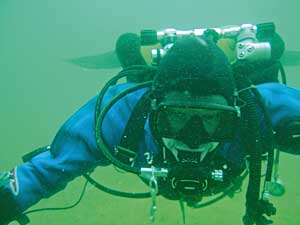 Since 2005, Andrea and I, assisted by Dr. Giovanna Flaim, a limnologist of the Fondazione E. Mach (FEM) in San Michele Adige, along with the archaeologists Alessandro and Luca Bezzi dell’Arc – the Cles Team, carried out a series of dives in the waters of Lake Tovel to try and map the forest’s submerged logs and produce a certain amount of photographic material. Since 2005, Andrea and I, assisted by Dr. Giovanna Flaim, a limnologist of the Fondazione E. Mach (FEM) in San Michele Adige, along with the archaeologists Alessandro and Luca Bezzi dell’Arc – the Cles Team, carried out a series of dives in the waters of Lake Tovel to try and map the forest’s submerged logs and produce a certain amount of photographic material.
The dives were also a good opportunity to take small samples of sediment in various parts of the lake. In general, the life cycle of the Dinophyceae is composed of a vegetative cell and a cyst. The former floats and multiplies in the water column until the environmental conditions remain favourable, but when these conditions change it becomes a cyst that sinks into the sediment. It can survive there for several years, and when the environmental conditions become suitable, the cyst germinates, giving rise to new vegetative cells and thus completing its life cycle. The cysts of the three Dinophyceae that make up our 'species complex' are distinct and useful for quick identification, unlike vegetative cells which are difficult to identify, as evidenced by all the confusion in the past. Through microscopic analysis of geo-referenced sediment, a map of the Dinophyceae cysts in the lake can be obtained. By combining their distribution with other information, such as temperature and nutrients, the intention was to reveal another piece of the Dinophyceae autecology puzzle, as well as the biotic and abiotic conditions that allow the formation of algae blooms in nutrient poor lakes such as Lake Tovel.
 The dives immediately proved to be difficult to manage: it was intensely cold (at a depth of 35 metres the water temperature is 4° C even in summer) with very low visibility, and due to its height of 1,178 metres above sea level, Tovel is considered to all effects and purposes a dive at high altitude, forcing the divers to carry out scrupulously careful planning. Most of the dives were carried out during the coldest months with the hope that a lower turbidity and a resulting better visibility would permit an ideal operating environment, despite very cold weather that brought even the uppermost water layer to a temperature of about 5 ° - 6 ° C. The dives immediately proved to be difficult to manage: it was intensely cold (at a depth of 35 metres the water temperature is 4° C even in summer) with very low visibility, and due to its height of 1,178 metres above sea level, Tovel is considered to all effects and purposes a dive at high altitude, forcing the divers to carry out scrupulously careful planning. Most of the dives were carried out during the coldest months with the hope that a lower turbidity and a resulting better visibility would permit an ideal operating environment, despite very cold weather that brought even the uppermost water layer to a temperature of about 5 ° - 6 ° C.
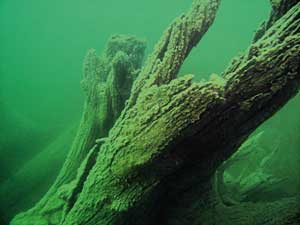 From the start, visibility permitting, the scenery below the water surface proved to be extraordinary, in fact nothing short of stunning: the trunks, some still with their roots embedded in the ground, others now uprooted and lying on their side, appeared in front of our masks in all their spectral and scary presence. Their shapes and their positions trigger the imagination of anybody looking at them from close up: you seem to be suspended between reality and a dream, between myth and fairy tale. Looking at this scenario cannot but remind you of the many popular legends of the Val di Non which are meant to explain the origins of the lake’s reddening. From the start, visibility permitting, the scenery below the water surface proved to be extraordinary, in fact nothing short of stunning: the trunks, some still with their roots embedded in the ground, others now uprooted and lying on their side, appeared in front of our masks in all their spectral and scary presence. Their shapes and their positions trigger the imagination of anybody looking at them from close up: you seem to be suspended between reality and a dream, between myth and fairy tale. Looking at this scenario cannot but remind you of the many popular legends of the Val di Non which are meant to explain the origins of the lake’s reddening.
Legend speaks of Tresénga, the beautiful daughter of the king of Ragoli, Lavinto di Tuenno. Lavinto, who was more interested in the conquest of the Ragoli territories than Queen Tresénga, forced the two respective hostile factions to fight on the shores of Lake Tovel. Ragoli's army was defeated and the beautiful Queen was killed by an arrow from Lavinto’s bow. This legend explains why the lake turns red every summer, a consequence of that terrible battle, and because every the lamentations of Queen Tresenga can be heard coming from the western shore.
|
 NUMBER10
NUMBER10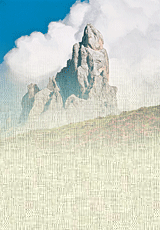
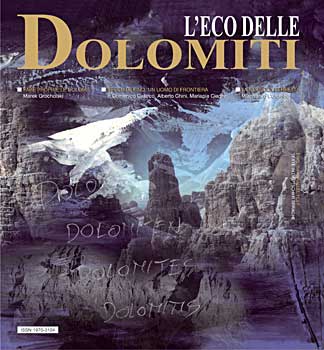

 This alga, which has been called Glenodinium sanguineum Marchesoni since 1941, has been described as a species with a considerable morphological and chromic plasticity. Following the studies carried out by the Fondazione E. Mach (FEM) in San Michele all’Adige, it is now known that in reality this alga is a ‘species complex’ composed of three algae, which explains the high ‘plasticity’ of Glenodinium sanguineum Marchesoni. The three species are the following: Baldinia anauniensis (the green form), Borghiella dodgei (the brown form) and Tovellia sanguinea (the ‘real’ red form). These algae are always present in the lake, but due to the different and less intense use of the lake’s overlying pastures, the consequent scarse trophic conditions do not permit a bloom.
This alga, which has been called Glenodinium sanguineum Marchesoni since 1941, has been described as a species with a considerable morphological and chromic plasticity. Following the studies carried out by the Fondazione E. Mach (FEM) in San Michele all’Adige, it is now known that in reality this alga is a ‘species complex’ composed of three algae, which explains the high ‘plasticity’ of Glenodinium sanguineum Marchesoni. The three species are the following: Baldinia anauniensis (the green form), Borghiella dodgei (the brown form) and Tovellia sanguinea (the ‘real’ red form). These algae are always present in the lake, but due to the different and less intense use of the lake’s overlying pastures, the consequent scarse trophic conditions do not permit a bloom. When you reach the front of the northern shore near outlet, the Tresenga stream, where there is a view of the entire lake, the emotion it generates is similar to the feeling you get by looking at a painting by the English landscape painter J. Constable: a true and authentic kaleidoscopic of concentrated emotion consisting of a set of colours and shapes which instils an atmosphere of spirituality and a sense of calm like no other. As with other experiences in life, once is not enough. Tovel is worth numerous visits to allow you to better understand its potential and the many facets of its beautiful colours: the predominance of green, typical in the summer, the impressionist palette of autumn, accompanied by a transparent green colour – the blue of its waters, like a mirror reflecting the surrounding peaks.
When you reach the front of the northern shore near outlet, the Tresenga stream, where there is a view of the entire lake, the emotion it generates is similar to the feeling you get by looking at a painting by the English landscape painter J. Constable: a true and authentic kaleidoscopic of concentrated emotion consisting of a set of colours and shapes which instils an atmosphere of spirituality and a sense of calm like no other. As with other experiences in life, once is not enough. Tovel is worth numerous visits to allow you to better understand its potential and the many facets of its beautiful colours: the predominance of green, typical in the summer, the impressionist palette of autumn, accompanied by a transparent green colour – the blue of its waters, like a mirror reflecting the surrounding peaks. Since the beginning of last century, iconography and period photos have shown the monumental presence of a fir tree emerging from the north–east part of the lake. The tree is no longer visible from the shores of the lake because of the effect of the ice, which invariably appears at the beginning of December and lasts until April, which has truncated the cusp, thereby concealing its presence. However, if you cross the lake by boat, you can detect the presence of the tree which is located a few metres below the surface. Thus, motivated by curiosity and the confidence derived from experience, some divers decided to explore the depths of the lake.
Since the beginning of last century, iconography and period photos have shown the monumental presence of a fir tree emerging from the north–east part of the lake. The tree is no longer visible from the shores of the lake because of the effect of the ice, which invariably appears at the beginning of December and lasts until April, which has truncated the cusp, thereby concealing its presence. However, if you cross the lake by boat, you can detect the presence of the tree which is located a few metres below the surface. Thus, motivated by curiosity and the confidence derived from experience, some divers decided to explore the depths of the lake. Since 2005, Andrea and I, assisted by Dr. Giovanna Flaim, a limnologist of the Fondazione E. Mach (FEM) in San Michele Adige, along with the archaeologists Alessandro and Luca Bezzi dell’Arc – the Cles Team, carried out a series of dives in the waters of Lake Tovel to try and map the forest’s submerged logs and produce a certain amount of photographic material.
Since 2005, Andrea and I, assisted by Dr. Giovanna Flaim, a limnologist of the Fondazione E. Mach (FEM) in San Michele Adige, along with the archaeologists Alessandro and Luca Bezzi dell’Arc – the Cles Team, carried out a series of dives in the waters of Lake Tovel to try and map the forest’s submerged logs and produce a certain amount of photographic material. The dives immediately proved to be difficult to manage: it was intensely cold (at a depth of 35 metres the water temperature is 4° C even in summer) with very low visibility, and due to its height of 1,178 metres above sea level, Tovel is considered to all effects and purposes a dive at high altitude, forcing the divers to carry out scrupulously careful planning. Most of the dives were carried out during the coldest months with the hope that a lower turbidity and a resulting better visibility would permit an ideal operating environment, despite very cold weather that brought even the uppermost water layer to a temperature of about 5 ° - 6 ° C.
The dives immediately proved to be difficult to manage: it was intensely cold (at a depth of 35 metres the water temperature is 4° C even in summer) with very low visibility, and due to its height of 1,178 metres above sea level, Tovel is considered to all effects and purposes a dive at high altitude, forcing the divers to carry out scrupulously careful planning. Most of the dives were carried out during the coldest months with the hope that a lower turbidity and a resulting better visibility would permit an ideal operating environment, despite very cold weather that brought even the uppermost water layer to a temperature of about 5 ° - 6 ° C. From the start, visibility permitting, the scenery below the water surface proved to be extraordinary, in fact nothing short of stunning: the trunks, some still with their roots embedded in the ground, others now uprooted and lying on their side, appeared in front of our masks in all their spectral and scary presence. Their shapes and their positions trigger the imagination of anybody looking at them from close up: you seem to be suspended between reality and a dream, between myth and fairy tale. Looking at this scenario cannot but remind you of the many popular legends of the Val di Non which are meant to explain the origins of the lake’s reddening.
From the start, visibility permitting, the scenery below the water surface proved to be extraordinary, in fact nothing short of stunning: the trunks, some still with their roots embedded in the ground, others now uprooted and lying on their side, appeared in front of our masks in all their spectral and scary presence. Their shapes and their positions trigger the imagination of anybody looking at them from close up: you seem to be suspended between reality and a dream, between myth and fairy tale. Looking at this scenario cannot but remind you of the many popular legends of the Val di Non which are meant to explain the origins of the lake’s reddening.